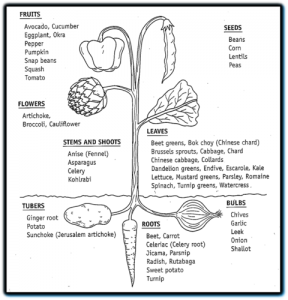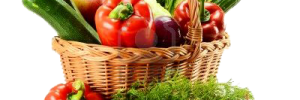How are vegetables classified?
Vegetables may be derived from almost any part of a plant: roots (carrots, beets, turnips, and radishes), bulbs (onions and garlic), stems (celery and asparagus), leaves (spinach and lettuce), seeds (beans, corn, and peas), and even flowers (broccoli and cauliflower). In addition, there are foods that are routinely called vegetables and used as vegetables, but which are actually fruits. Botanically, fruits are the part of the plant that contains its seeds, specifically, the mature ovaries of plants. The fruits most often seen masquerading as vegetables include tomatoes, squash, cucumbers, avocados, okra, eggplant, olives, water chestnuts, and peppers.
Composition of Vegetables
Structure
 Cell Wall. Cells are the building blocks of both plant and animal organisms. One of the major differences between the two is that vegetables and other plants lack the skeletal structure that provides support in animal organisms. Instead, each vegetable cell is surrounded by a sturdy wall. Contributing to the strength of these cell walls are several fibrous compounds which are indigestible in humans-cellulose, pectic compounds, hemicellulose, lignin, and gums. Humans lack the enzyme necessary to digest cellulose to the glucose molecules that the body can use.
Cell Wall. Cells are the building blocks of both plant and animal organisms. One of the major differences between the two is that vegetables and other plants lack the skeletal structure that provides support in animal organisms. Instead, each vegetable cell is surrounded by a sturdy wall. Contributing to the strength of these cell walls are several fibrous compounds which are indigestible in humans-cellulose, pectic compounds, hemicellulose, lignin, and gums. Humans lack the enzyme necessary to digest cellulose to the glucose molecules that the body can use.
Pectic compounds and hemicellulose are fibers found within and between cell walls where they serve as a type of intra- and intercellular cement, giving firmness and elasticity to the tissues. The outer layer of the skin, peel, or rind has a higher proportion of cellulose and hemicellulose than the inner, thinner layers. The surface cells of these protective layers secrete a waxy cutin, a water-impermeable coat that protects the plant.
Lignin is a non-carbohydrate compound (polymers of phenolic alcohols), which increases in concentration as vegetables mature. This is why spinach stems and the inner cores of carrots, asparagus spears, and broccoli become tougher with age and do not soften when heated. Other fibrous compounds found in plants include gums, polysaccharides with a unique ability to absorb water and swell to several times their original volume. They are often added to processed foods such as ice cream, candies, and salad dressings to increase their viscosity Examples of food gums derived from plants include algin, carob bean gum, carrageenan, gum arabic, gum guar, locust bean, gum tragacanth, and gum karaya.
Parenchyma Cells. The cell walls of vegetables and fruits surround cells, the most common of which is the parenchyma cell. Within the jelly-like cytoplasm of these cells are the compounds responsible for the plant’s starch content, color, water volume, and flavon Several of these substances, such as starch and pigments, are stored in organelles called plastids. There are three types of plastids: leucoplasts, chloroplasts, and chromoplasts.
Leucoplasts store starch and some water. Starch stored by these parenchyma cells serves as the major digestible portion of the plant. Many vegetables and fruits are consumed for their starch content and resulting source of energy.
In addition to providing starch, parenchyma cells contain pigments that add the color found in many vegetables and fruits. The chloroplast plastids contain the chlorophyll that is essential for carbohydrate synthesis and provides the green color of plants. The orange-yellow colors of certain vegetable and fruits are derived from the chromoplast plastids that contain the carotene or xanthophyll pigments.
Another function of the parenchyma cells is to store water and other compounds in sacs called vacuoles. The size of the cell is often related to the amount of liquid it holds, which determines the juiciness of the vegetable or fruit. Juiciness ranges from very little in potatoes and bananas to very high in tomatoes and watermelon. The optimum water content provides turgor and crunchiness to leafy vegetables like lettuce and spinach. Heat or humidity reduces turgor in plants. Other substances found in the cells’ vacuoles besides liquid are the red-blue pigments known as anthocyanins and an array of flavor compounds such as saccharides, salts, and organic’ acids. Organic acids found in the cell contribute to its pH and to the food’s flavor and acidity. Most vegetables have a pH of about 5.0 to 5.6, with tomatoes slightly lower (pH 4.0 to 4.6) and corn, peas, and potatoes slightly higher (pH 6.1 to 6.3).
Intercellular Air Spaces. Plant cells do not fit tightly next to each other, so intercellular spaces – the spaces between cells – fill with air, adding volume and crispness to vegetables and fruits. How close the cells are to each other influences the textural differences between fruits and vegetables in terms of their crispness. Air spaces account for only 20 to 25 percent of the volume of an apple, 15 percent of a peach, and only 1 percent of a potato. Without the air, both vegetables and fruits would be soft and flaccid.
Pigments
Vegetables (and fruits) are clothed in all the colors of the rainbow, and so brighten meals that would otherwise look bland with only meat, dairy products, grains, and bread on the table. The selection of fruits and vegetables is often based upon the way they look, and color is an important attribute of a meal’s appearance.
Plant pigments fall into three major groups: carotenoids (yellow-orange), chlorophylls (green), and flavonoids. Carotenoids and chlorophylls are found in plastids and are fat soluble. Flavonoid pigments are water soluble. and have a tendency to be lost in cooking water.
Carotenoids. Carotenoids (alpha-, beta-, and gamma-carotenes), along with lycopenes and xanthophylls, account for most of the yellow-orange and some of the red color of fruits and vegetables. Carotenes lend reddish-orange color to carrots and winter squashes. Lycopenes, which are deeper red, provide the bright color of tomatoes. Light yellow xanthophyll pigments color pineapples.
Heat affects the color of vegetables, most likely because it modifies the pigments’ chemical structure. Exposure to oxygen also causes oxidation of pigments and a resulting loss in color. Vegetables containing beta-carotene should not be overheated, because this pigment not only contributes to color but can also be converted to vitamin A; therefore, its destruction would be doubly undesirable.
Chlorophyll. Chlorophyll, the pigment responsible for the green color of plants, also makes possible the essential process of photosynthesis, in which leaves capture the sun’s light energy to convert carbon dioxide and water to carbohydrates. It is not surprising that plants rich in chlorophyll include most of the leafy green vegetables like lettuce, spinach, broccoli, green cabbage, and kale.
In older plants or those picked and exposed to sunlight, chlorophyll is degraded, causing underlying pigments to show. This is why leaves may turn , yellow in fresh parsley or broccoli florets left too long on the produce stand. The process is similar to what happens in autumn, when the non-green colors, which have been in the leaves all along but masked by the darker, green chlorophyll, are allowed to show as the chlorophyll diminishes with the changing light and cooler temperatures.
Chlorophyll may also be hidden by the air between the cells in fresh vegetables. Sometimes the green color can be enhanced by blanching the vegetable, which causes the air to bubble away so that it no longer clouds the colors. The brighter green seen in frozen vegetables is caused by blanching them before freezing. Raw vegetable platters prepared by caterers are often more brilliant in color because the vegetables have been blanched and then dipped quickly in cold water to stop the cooking.
Chlorophyll is a fat-soluble pigment, and is not as stable as carotenoid pigments. Thus, while heating green vegetables causes them at first to turn a sharp, bright green, longer heating periods such as those required for canning cause them to turn a dull olivebrown-the color often seen in canned spinach or peas. This heat-induced color change occurs when membranes that previously separated acids and pigments are disrupted, allowing acids to come in contact with chloroplasts. Hydrogens from the acids replace the magnesium in the chlorophyll, which results in an olive-brown compound known as pheophytin. Color changes in green vegetables can be minimized by keeping heating times short, adding a small amount of sugar, and cooking the food uncovered for the first few minutes to allow volatile organic acids to escape.
Flavonoids. Flavonoid pigments include anthocyanins (red-blue), anthoxanthins (creamy to white), and betalains (purplish-red).
Anthocyanin. Most of the red, purple, and blue colors seen in fruits and vegetables derive from anthocyanin. Although numerous fruits contain this pigment, it is found in only a few vegetables – red cabbage, eggplant, radish, and red potato.
The color of anthocyanins in these foods is affected by several factors, including changes in pH that may occur during simmering. Acidic tap water intensifies the red color of anthocyanins; alkaline water changes the reddish-blue hue first to an unappetizing blue and then to green. The latter process is sometimes observed in red cabbage and can be prevented by adding acid ingredients such as apple, lemon juice, or vinegar. This pigment will also turn to off-colors if it is exposed to metal ions from knives or containers made of iron, tin, or aluminum, as seen when red cabbage turns purple-blue when it is cut with a non-stainless metal knife. Stainless steel and glass are consequently the best choices for the preparation and storage of foods rich in anthocyanins.
Anthoxatithins. Anthoxanthins are actually a composite of compounds known as flavones. flavonols, and flavonones. They are the reason for the cream or white color of cauliflower, onions, white potatoes, and turnips. Further whitening can be achieved by adding acidic ingredients like cream of tartar or vinegar. Anthoxanthins turn an undesirable yellow color in alkaline water, and can even change to blue-black or red-brown under excessive heating or in the presence of iron or copper.
Betalains. Betalain pigments (red betacyanins and yellow betaxanthins) give beets their deep purplish-red color. It is important to leave beets unpeeled until after they are cooked in order to prevent their rich color from bleeding out into the water. For the same reason, 1 or 2 inches of stem should be left at the top during cooking. Acidic ingredients like vinegar convert the purplish-red hue of beets to a brighter red. In an alkaline medium, the red color shifts to yellow.
